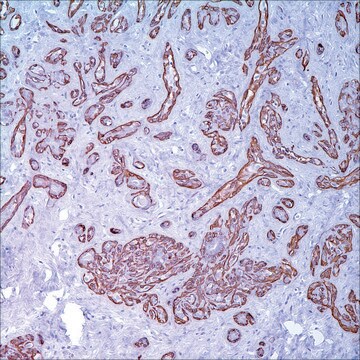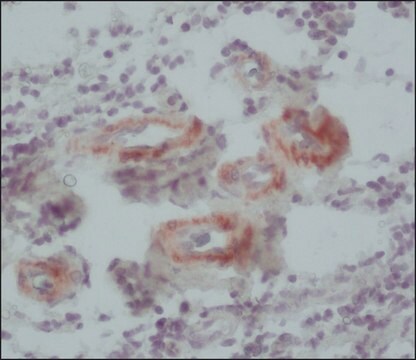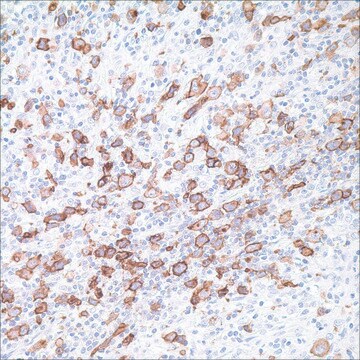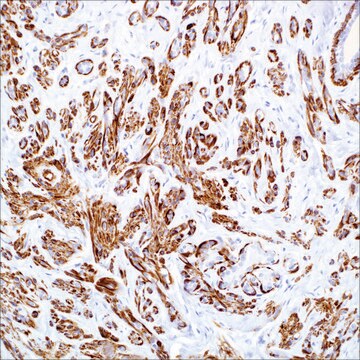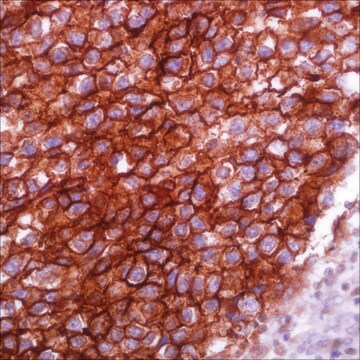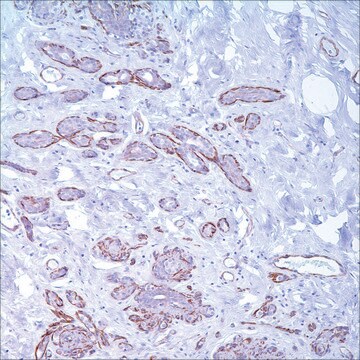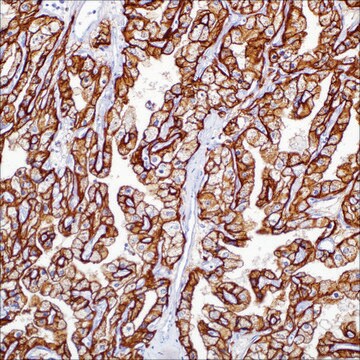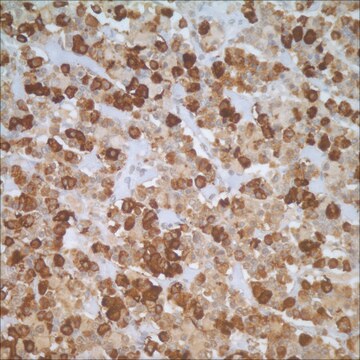推荐产品
生物源
mouse
品質等級
100
500
共軛
unconjugated
抗體表格
culture supernatant
抗體產品種類
primary antibodies
無性繁殖
CALP, monoclonal
描述
For In Vitro Diagnostic Use in Select Regions (See Chart)
形狀
buffered aqueous solution
物種活性
human
包裝
vial of 0.1 mL concentrate (231M-14)
vial of 0.5 mL concentrate (231M-15)
bottle of 1.0 mL predilute (231M-17)
vial of 1.0 mL concentrate (231M-16)
bottle of 7.0 mL predilute (231M-18)
製造商/商標名
Cell Marque™
技術
immunohistochemistry (formalin-fixed, paraffin-embedded sections): 1:100-1:500
同型
IgG1κ
控制
appendix
運輸包裝
wet ice
儲存溫度
2-8°C
視覺化
cytoplasmic
一般說明
Calponin is a 34 kD polypeptide that interacts with actin, tropomyosin, and calmodulin. It is involved in smooth muscle contraction mechanism and is restricted exclusively to smooth muscle tissue. Anti-calponin has been found to be useful in differentiating benign sclerosing lesions of the breast from carcinoma. Calponin positivity has also been noted in malignant myoepithelioma and pleomorphic adenoma of salivary gland origin, as well as angiomatoid malignant fibrous histiocytoma.
品質
 IVD |  IVD |  IVD |  RUO |
聯結
Calponin Positive Control Slides, Product No. 231S, are available for immunohistochemistry (formalin-fixed, paraffin-embedded sections).
外觀
Solution in Tris Buffer, pH 7.3-7.7, with 1% BSA and <0.1% Sodium Azide
準備報告
Download the IFU specific to your product lot and formatNote: This requires a keycode which can be found on your packaging or product label.
其他說明
For Technical Service please contact: 800-665-7284 or email: service@cellmarque.com
法律資訊
Cell Marque is a trademark of Merck KGaA, Darmstadt, Germany
Not finding the right product?
Try our 产品选型工具.
儲存類別代碼
12 - Non Combustible Liquids
水污染物質分類(WGK)
WGK 2
閃點(°F)
Not applicable
閃點(°C)
Not applicable
Antibodies to novel myoepithelium-associated proteins distinguish be-nign lesions and carcinoma in situ from invasive carcinoma of the breast
Wang NP, Wan BC, et al.
Appl. Immunohistochem., 5(3), 141-151 (1997)
J C Fanburg-Smith et al.
Human pathology, 30(11), 1336-1343 (1999-11-26)
Angiomatoid "malignant" fibrous histiocytoma (AMFH) has been considered to be a low-grade sarcoma of childhood, and, with its fibrous pseudocapsule, angiomatoid change, dense lymphoplasmacytic response, and proliferation of spindled or round cells, has been classified as a fibrohistiocytic neoplasm. We
A T Savera et al.
Modern pathology : an official journal of the United States and Canadian Academy of Pathology, Inc, 10(11), 1093-1100 (1997-12-05)
Myoepithelial cells of salivary glands have a complex cytoskeletal immunophenotype. To elaborate the smooth muscle phenotype of salivary gland myoepithelium and to assess its contribution to the histogenesis of pleomorphic adenomas, we evaluated the immunohistochemical expression of three novel monoclonal
T Nagao et al.
Cancer, 83(7), 1292-1299 (1998-10-08)
Malignant myoepithelioma (MME) of the salivary gland, also known as myoepithelial carcinoma, is rare and its biologic behavior has not been clarified fully. Ten cases of MME were analyzed for their clinicopathologic features and immunohistochemical characteristics, focusing on prognostic factors
Jason L Hornick et al.
The American journal of surgical pathology, 27(9), 1183-1196 (2003-09-10)
Myoepitheliomas and mixed tumors were only recently recognized to occur primarily in soft tissue, and only small case numbers have been described. To characterize these tumors further and to evaluate prognostic parameters, 101 myoepithelial tumors of soft tissue were retrieved
我们的科学家团队拥有各种研究领域经验,包括生命科学、材料科学、化学合成、色谱、分析及许多其他领域.
联系技术服务部门